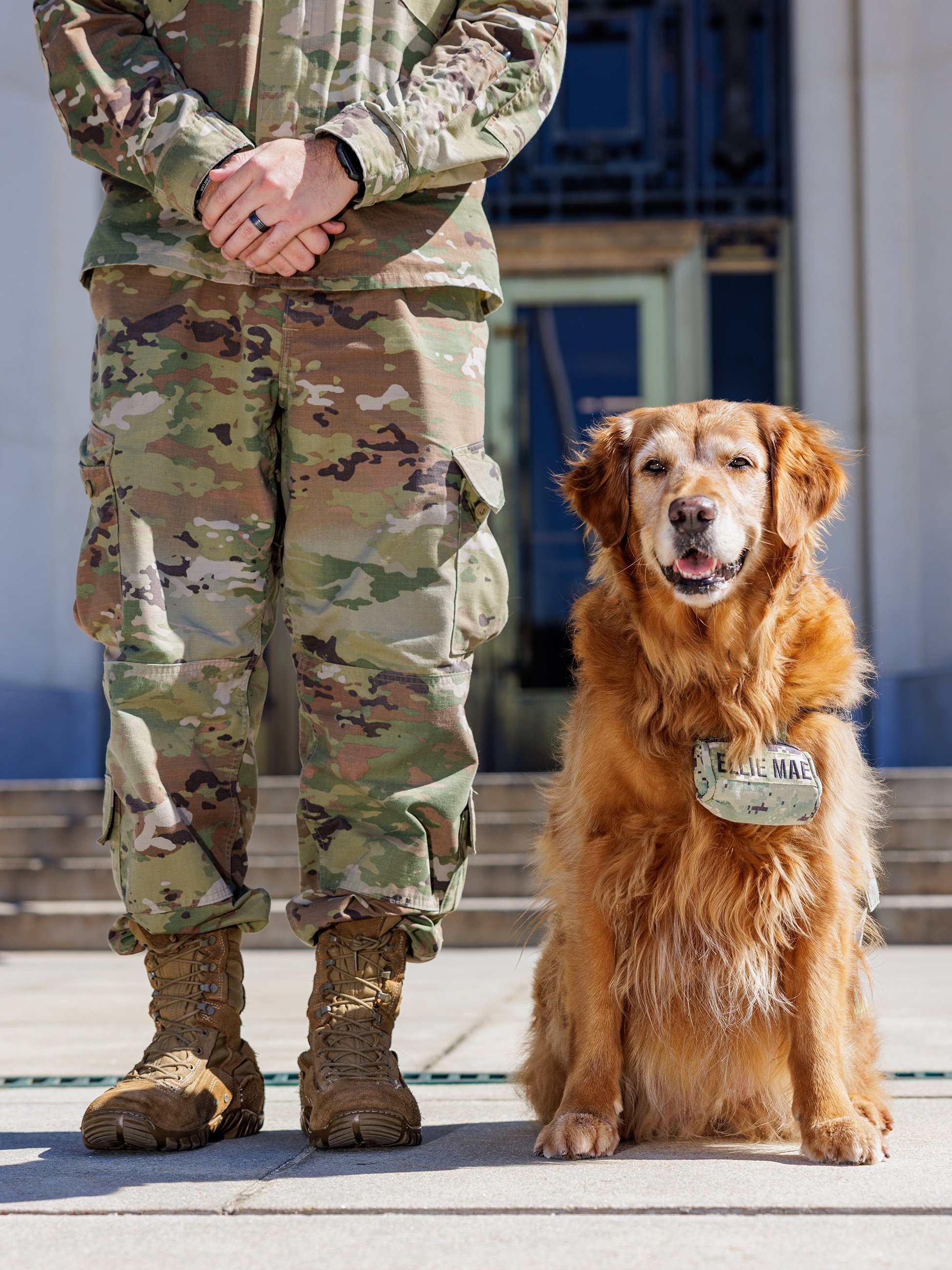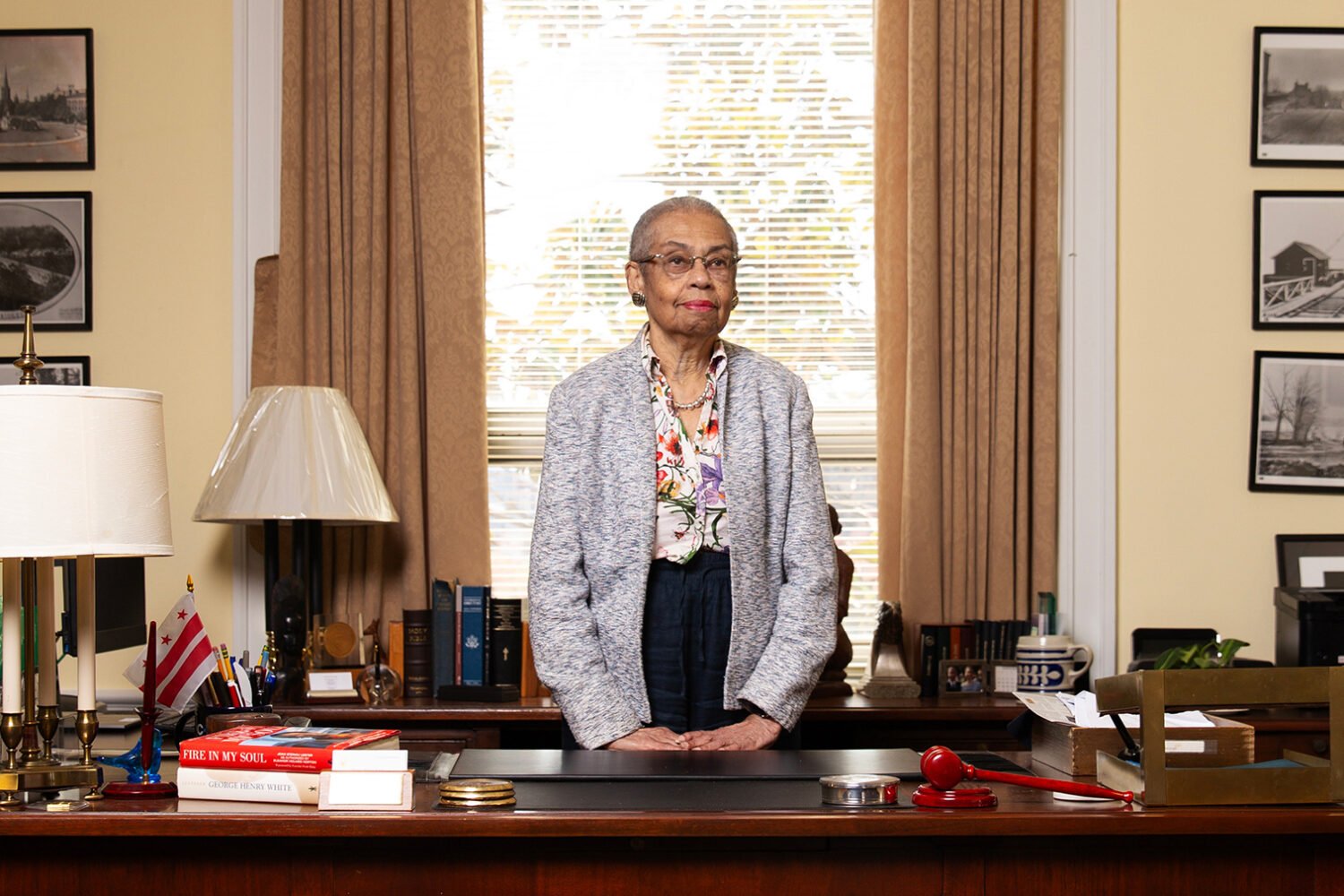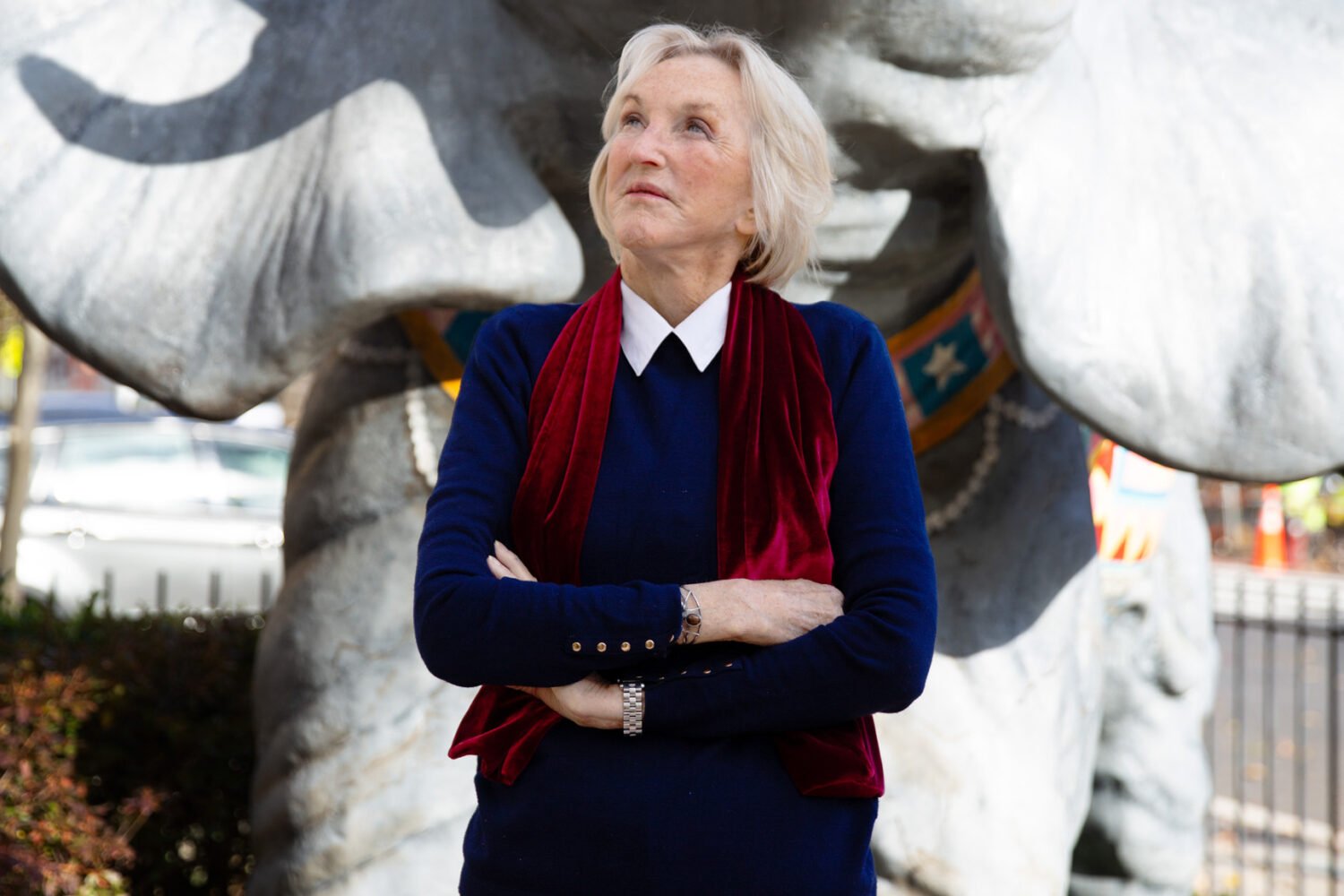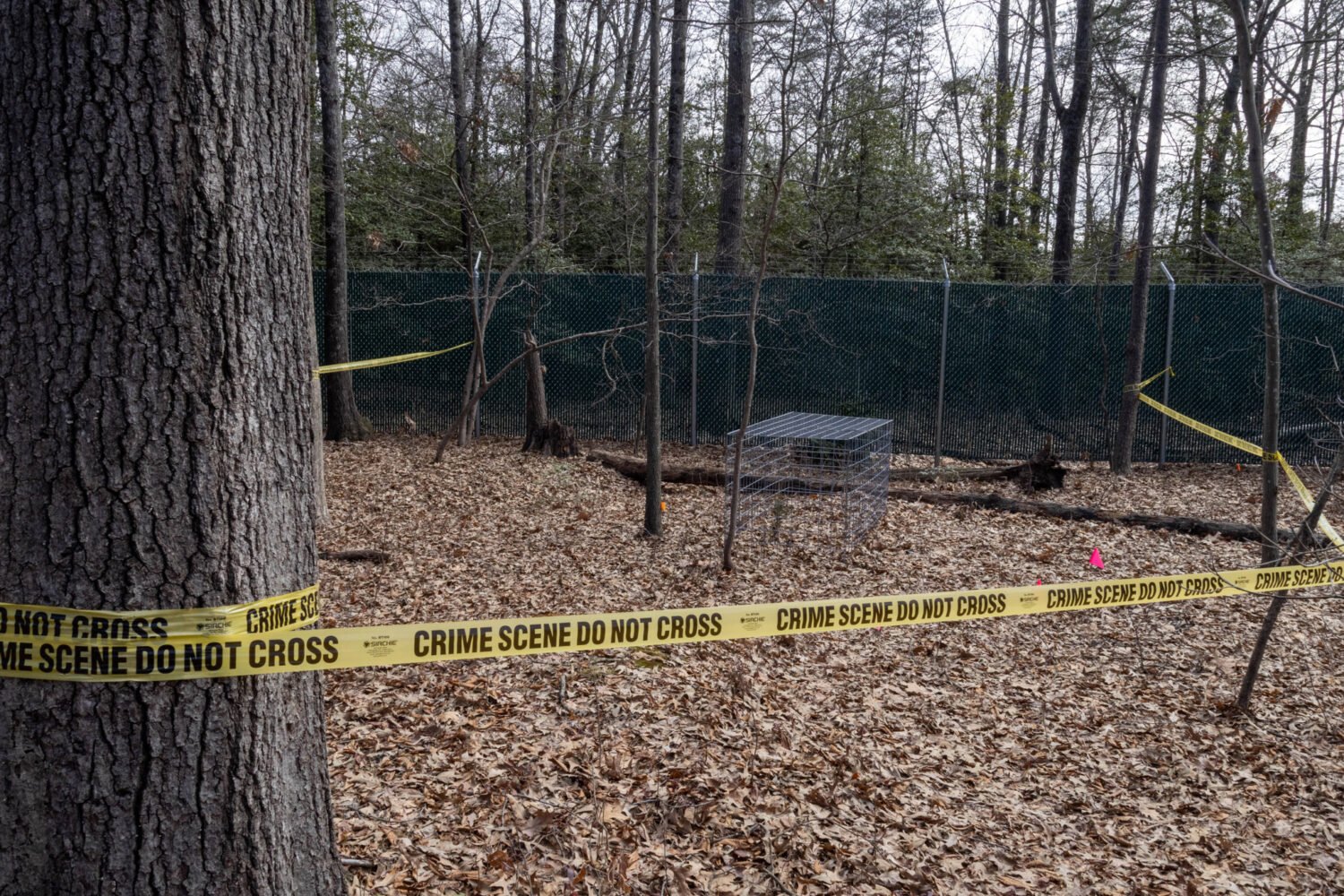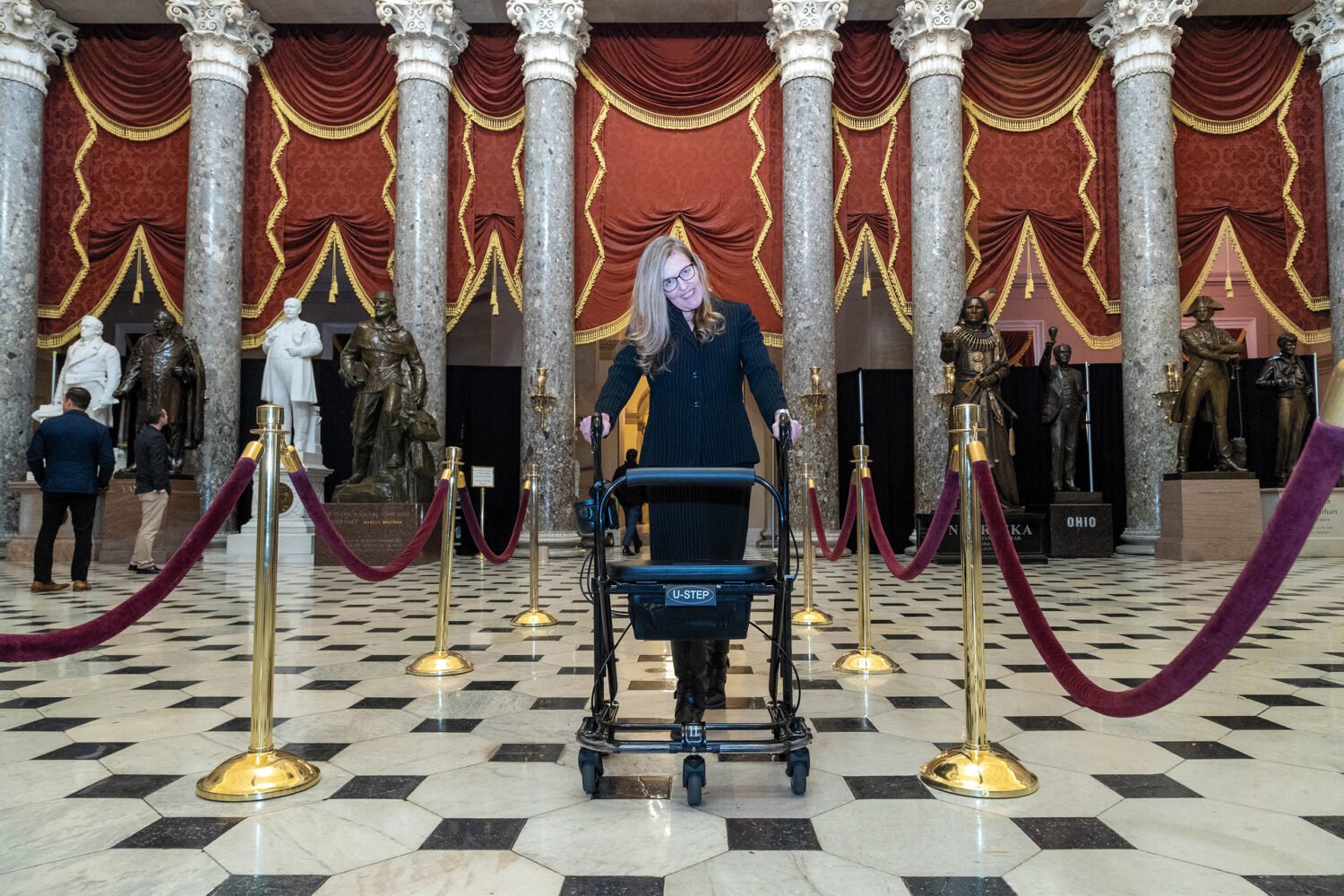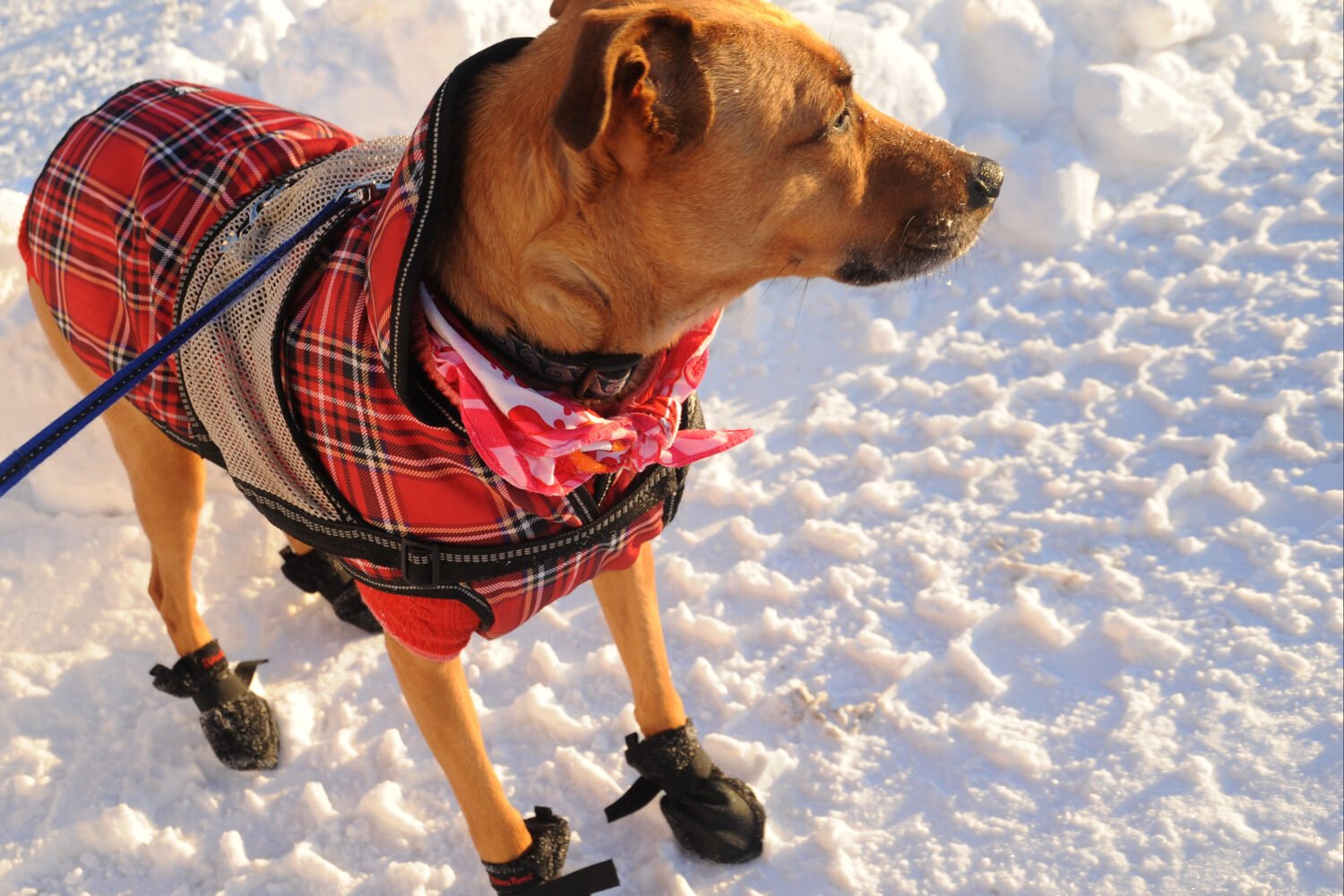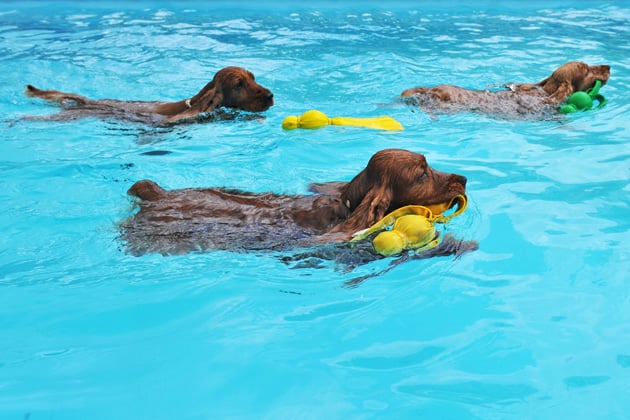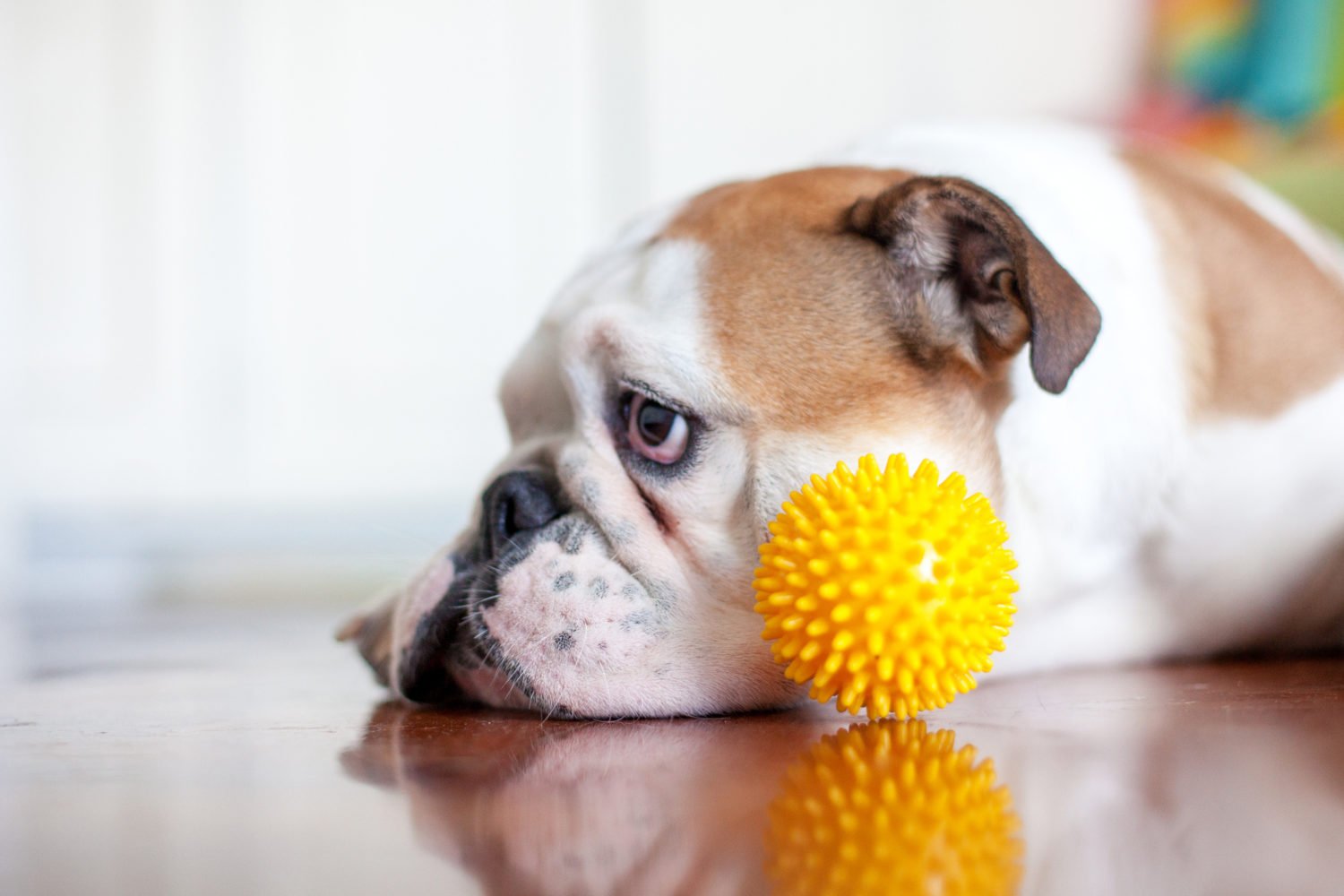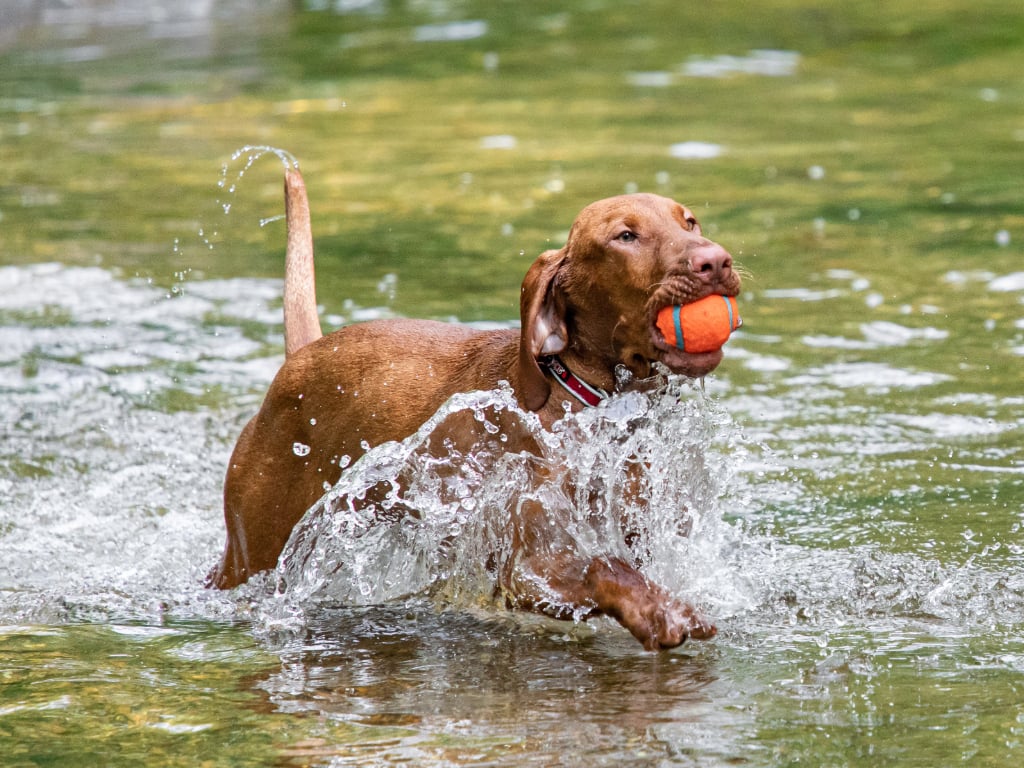Contents

long time ago, my family had a backyard pool. I would waddle toward the water, a curious and determined toddler, unaware that I didn’t know how to swim. Unfailingly, our dog—a high-strung collie/Australian shepherd named Sheila, a dead ringer for TV’s Lassie—would swoop in and knock me flat on my butt, averting potential disaster. Years later, when I was a teen, Sheila would still bark like the house was on fire every time I took a dip.
Looking back, I can’t blame her. She was only doing her job.
Humans and dogs have been laboring together for thousands of years, and scientists believe that many of the canine qualities we love are rooted in generations of purposeful breeding for particular tasks. Dogs have herded our livestock, guarded our property, hauled our sleds, helped us hunt. We’ve taken them to war (as far back as a battle in what is now Turkey, circa 600 BCE) and to outer space (a Russian dog, Laika, was the first animal to orbit the Earth).
Today, many dogs enjoy lives of domestic companionship: Belly rubs and playing fetch is their job. But others are still hard at work. Three years ago, the federal government employed about 5,600 dogs in roles ranging from detecting bioweapons and nuclear material to helping rangers traverse Denali National Park in winter. In Washington, working dogs are sniffing for bedbugs, helping wounded veterans live fuller lives, keeping the National Mall free of pesky geese, and otherwise getting the job done. Here are a few of their stories.
—Patrick Hruby
The Bedbug Sniffer

Ellie
German shepherd, almost 2
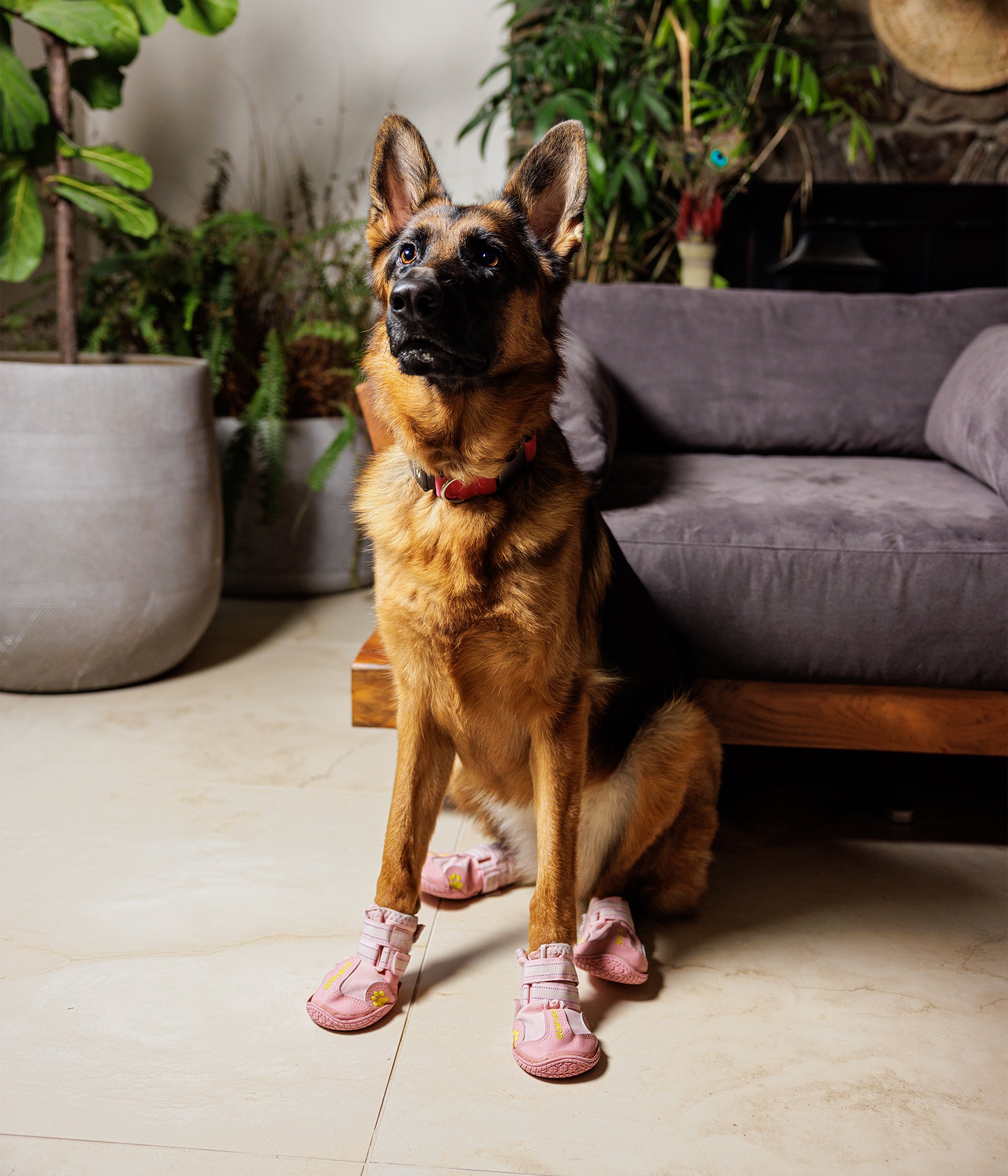
After about a year and a half of training, Ellie is at the beginning of her career. A few months back, she saw her first client, a woman in DC who was still getting bedbug bites, even after her apartment was chemically treated three times.
Bonita Parker, owner of Potomac Working Dogs, led Ellie around the apartment. She hit on the scent in a closet, pointing to several infested bags of clothes. Ellie also hit on a suitcase, and a light bulb went off for the client: This might be the source of the infestation, since she’d traveled with it right before the bites began.
Such is the advantage, Parker says, of hiring a dog like Ellie. Compared with a typical pest-control company, she can better help determine the scale and location of the problem, thereby allowing the subsequent treatment to be targeted. Parker and Ellie take this work very seriously; Ellie trained with a man who teaches military dogs to hunt for explosives. “He is very much about precision, because in explosive detection, there is really no room for error,” Parker says.
Still, Ellie remains a playful adolescent—during a Zoom call, Parker tried to coax her into her lap, then settled her dog on the floor with a treat. “She has a great on/off switch,” Parker says. “She’s like, ‘I’m in my play mode. I’m gonna do all the puppy things.’ And then it’s like, ‘Oh, I’m working.’ It’s a complete personality change.”
Back to Top
The Therapist

Captain Ellie Mae
Golden retriever, 6
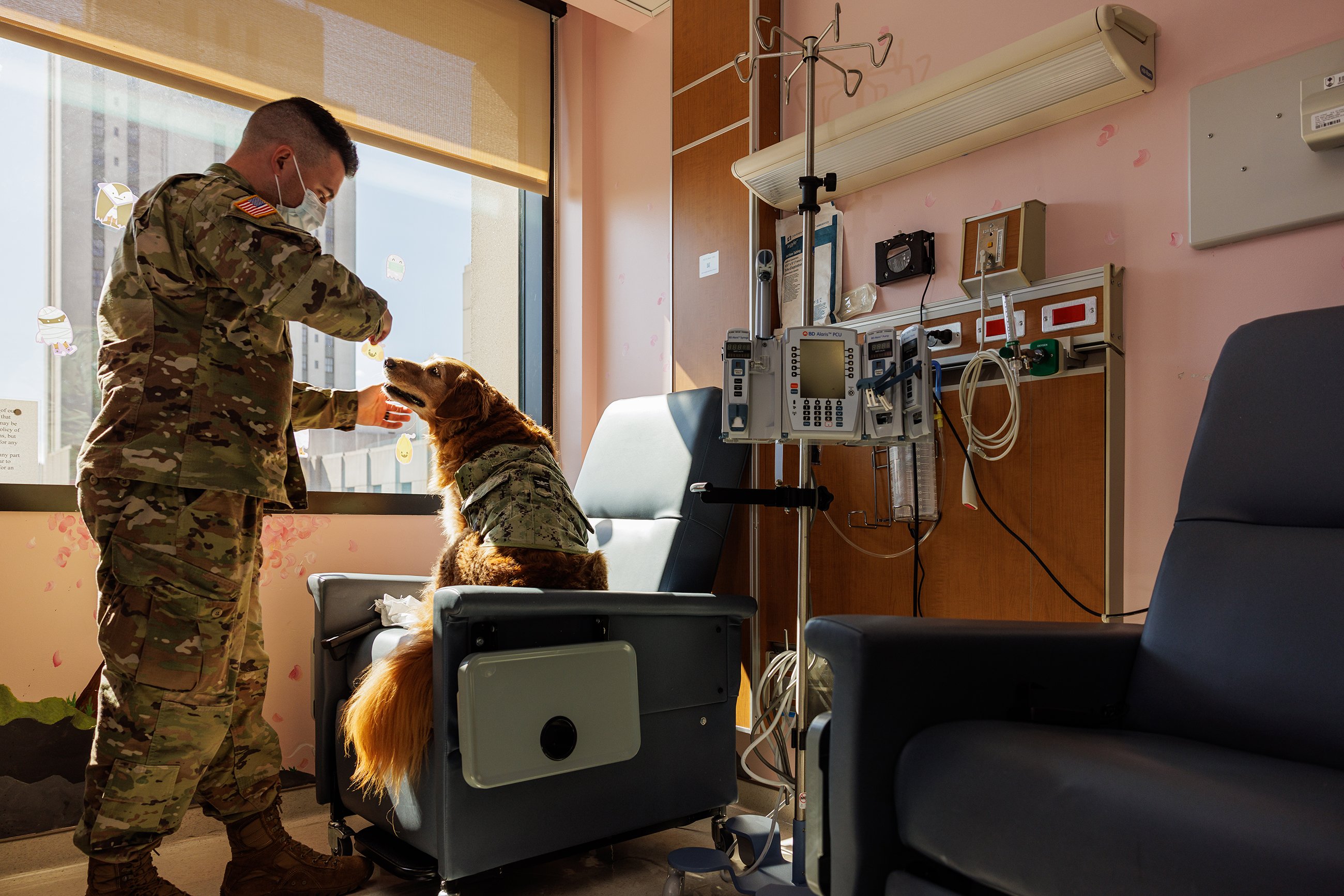
Despite her badass camo vest, honorary Navy captain Ellie Mae hasn’t seen combat. As much as a dog can, though, she understands the toll of war on the human body and psyche. Specially bred and trained, she’s hypersensitive to the needs of veterans and injured servicemembers—a perfect fit for the therapy-dog program at Walter Reed National Military Medical Center, where she and seven other dogs roam the halls with a team of handlers.
While Ellie Mae can care for patients with mobility issues by opening doors and retrieving fallen objects from the floor, much of her work is emotional: Have you ever felt the rush of serotonin when a big, fluffy dog leans lovingly against your legs? “Her skill is love,” says Amy O’Connor, who heads the therapy-dog program. “That’s her superpower.”
Walter Reed isn’t just for Presidents and wounded warriors. Military family members are treated here, too. Ellie Mae spends a lot of time in the pediatric oncology ward, where the cartoons and patterns painted on the walls can lift spirits only so much. She’s often the dog of choice for kids going through chemo and other taxing treatments, because she pours on the affection, clambering into bed with them. In the hospital’s halls, passing families will often call to her by name. “They don’t know us half the time,” says Patty Barry, Ellie Mae’s dog mom and the program’s business manager. “But they certainly know her.”
Back to Top
The Rat Hunters

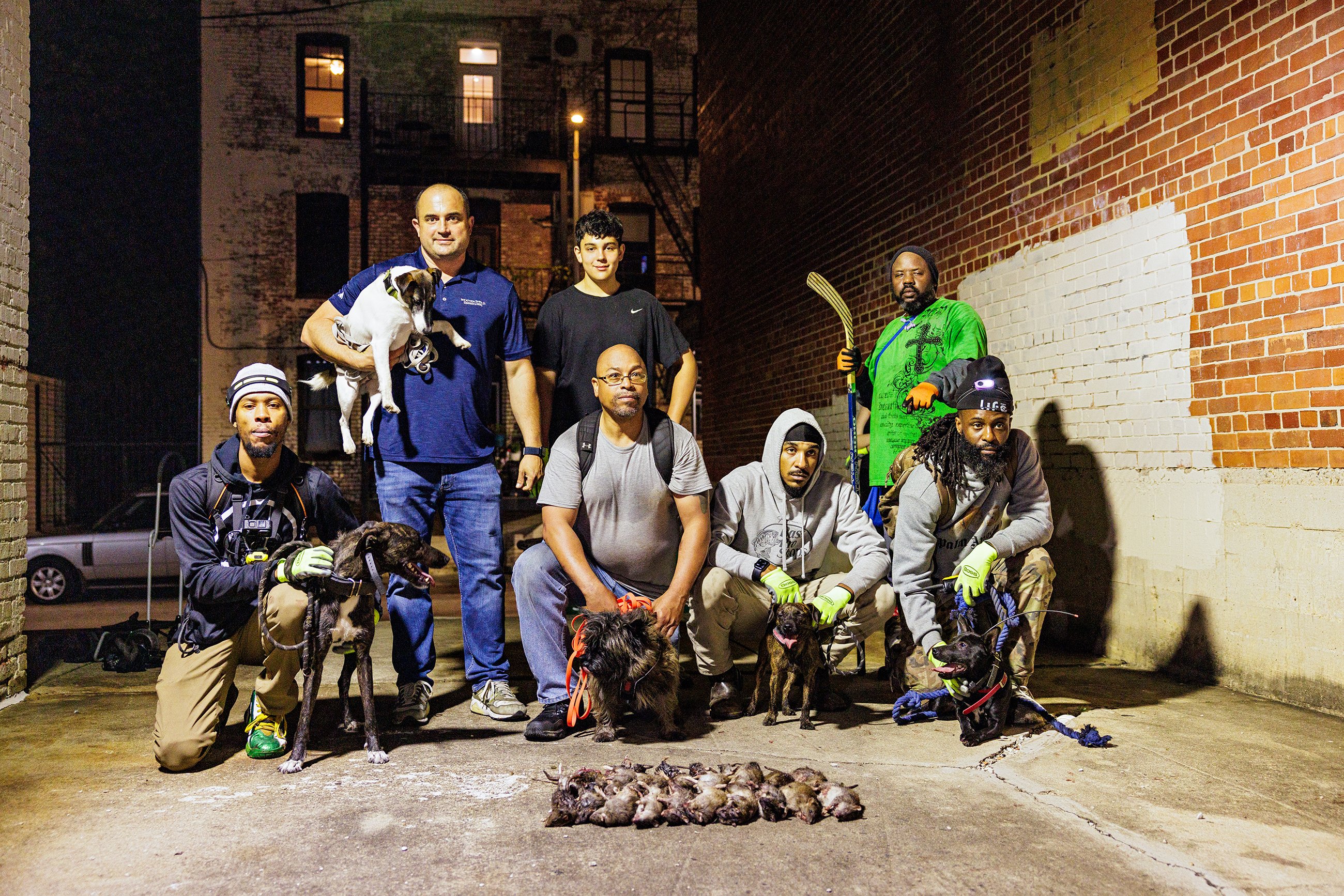
Choir Boy
Staghound, whippet, and pit-bull mix, 2
Mike
Smooth fox terrier, 4
Barto
Cairn terrier, 3
Pebbles
Patterdale and American pit-bull terrier mix, 2
Junior
Patterdale terrier, 11/2
They call themselves the Renegade Rebel Ratters, and on a Saturday night in October, they gather in Adams Morgan to do what they do best: hunt rats. “The dogs like doing it, and we like doing it,” says group cofounder Bomani Mtume as his cairn terrier, Barto, readies himself for battle by looking, well, adorable. Mtume and Barto have hunted rats all over DC, but in the past year and a half, they’ve made this their favorite haunt after striking a deal with the local business district: free parking for a night of hunting.
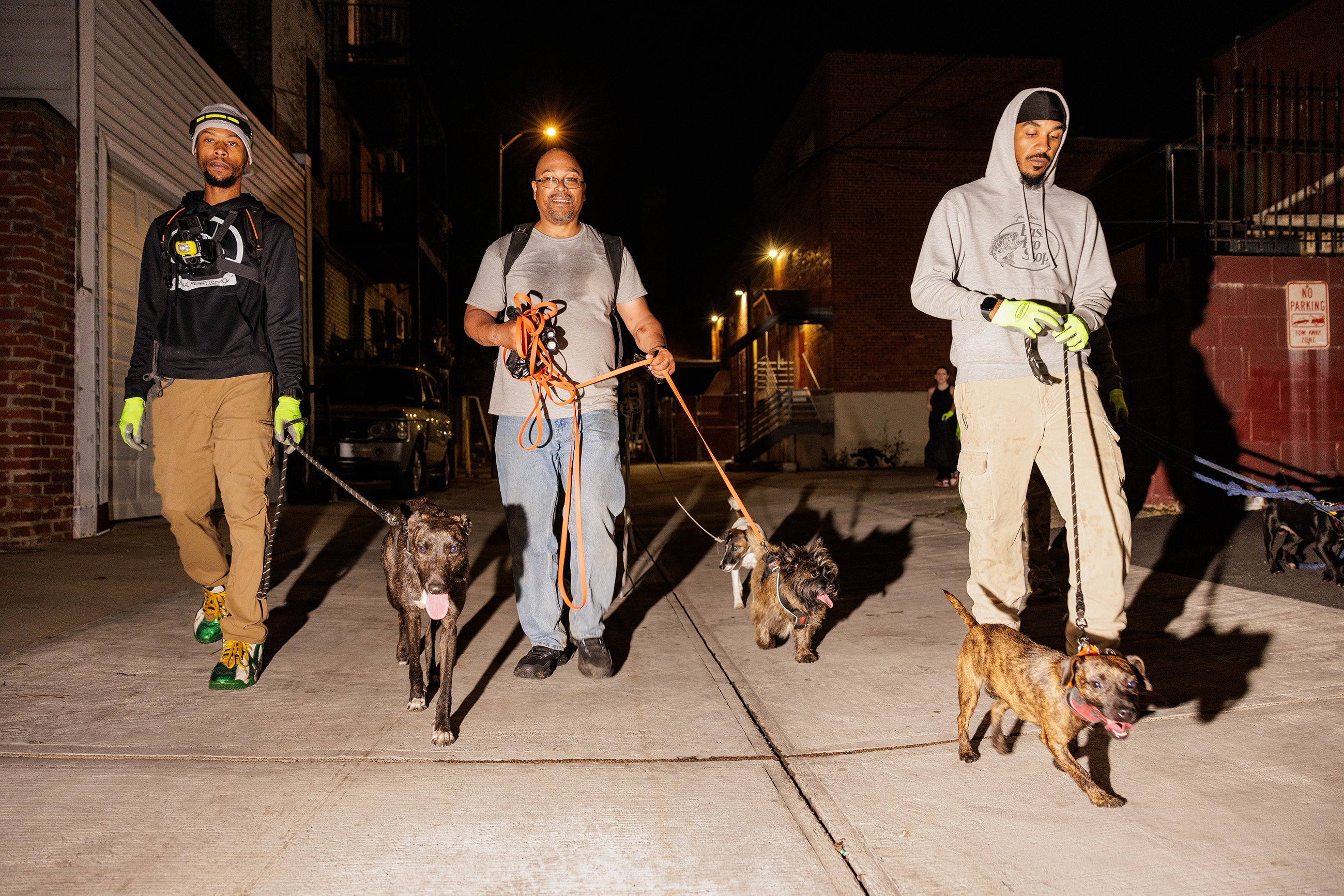
There’s a rich history of dogs hunting rats—a similar New York City group first formed in the mid-1990s. But the need has never been greater in DC, recently named the nation’s “rattiest” city. Mtume helps organize hunts in which different dogs play different roles. “Push” dogs go into tight spaces, such as behind dumpsters, to flush rats out of hiding. “Catch” dogs, like Barto, are “genetically hardwired to hunt vermin,” Mtume says. “All they want to do is kill rats.” Then there are “lurchers”—bigger and faster dogs who mop up the rats that escape.
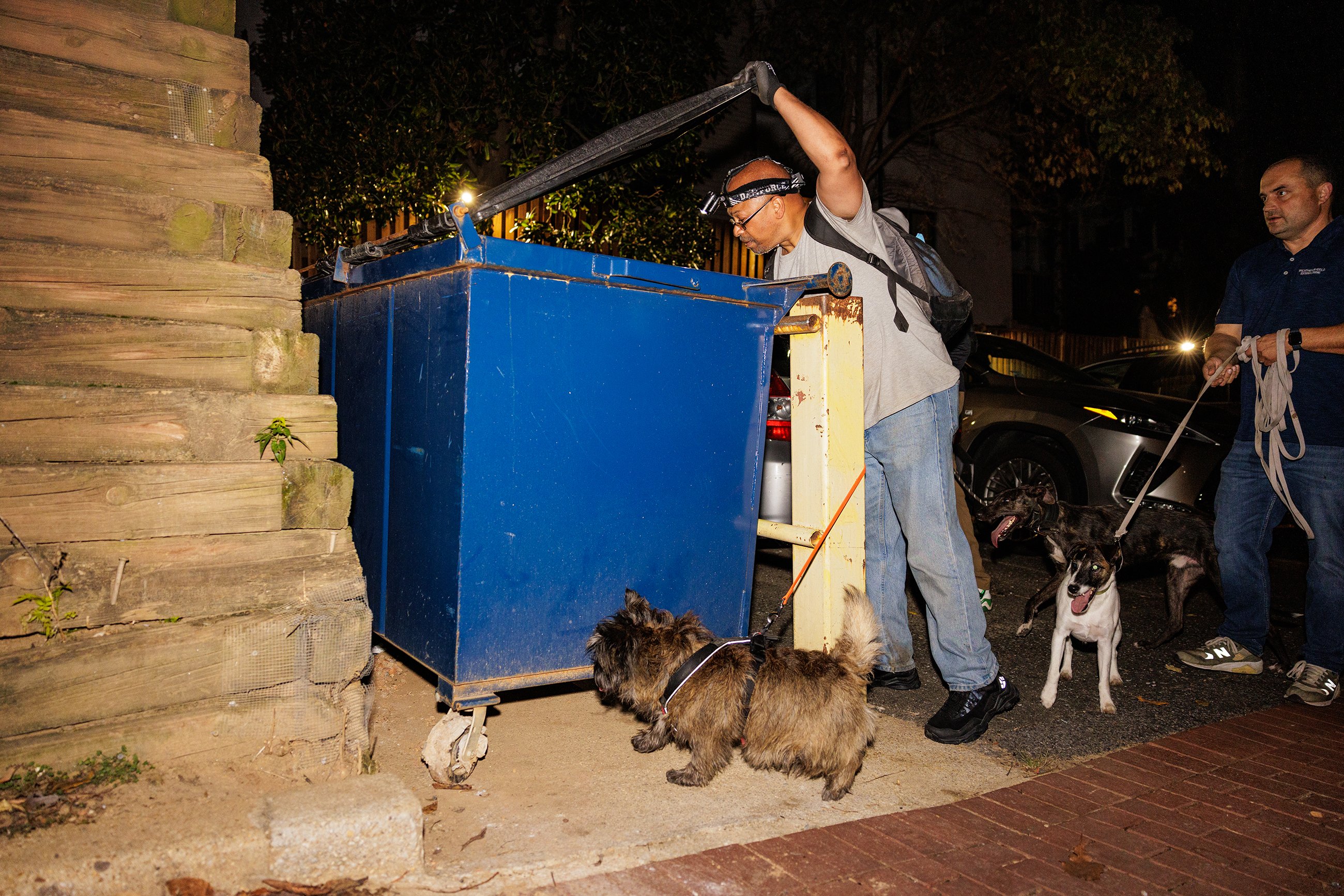
The dogs shake the rats violently by the neck. Groups such as People for the Ethical Treatment of Animals and DC’s Humane Rescue Alliance have criticized this practice. The dogs’ owners counter that death via canine happens within seconds, whereas rat poison used by exterminators causes internal bleeding and organ failure that can last as long as two weeks.
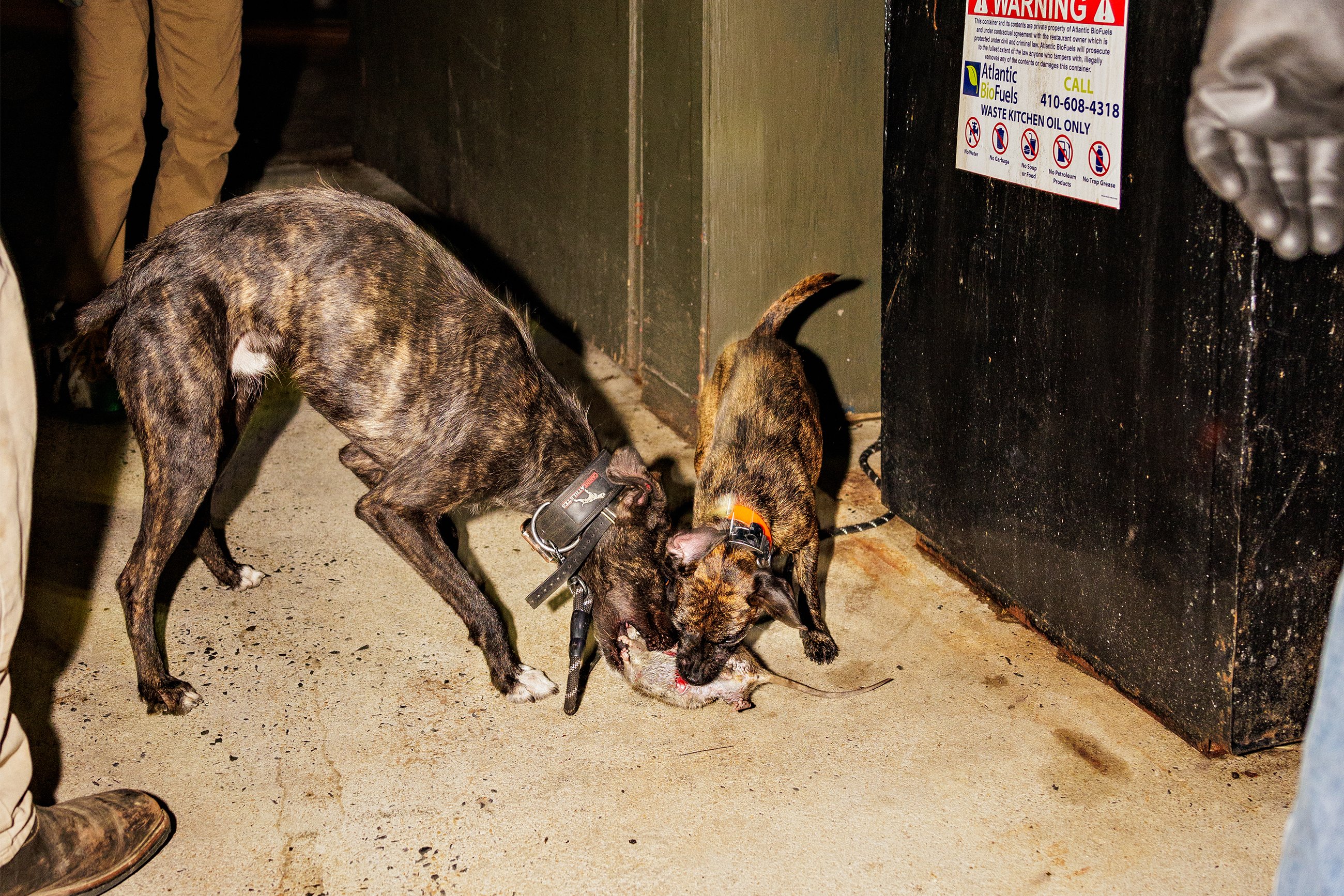
The dogs have never gotten sick, Mtume says, though they do suffer occasional bites. At 10 pm, the hunt begins behind a pair of green dumpsters and loops through the alleyways behind 18th Street. When it ends around midnight, the group has caught 29 rats, short of their record of 47. Along the way, a passing reveler voices his approval. “Thank you for your service,” he says. “Can I get a picture with the dogs?”
Back to Top
The Influencers

Ellie and Emma
Golden retrievers, 8 and 2
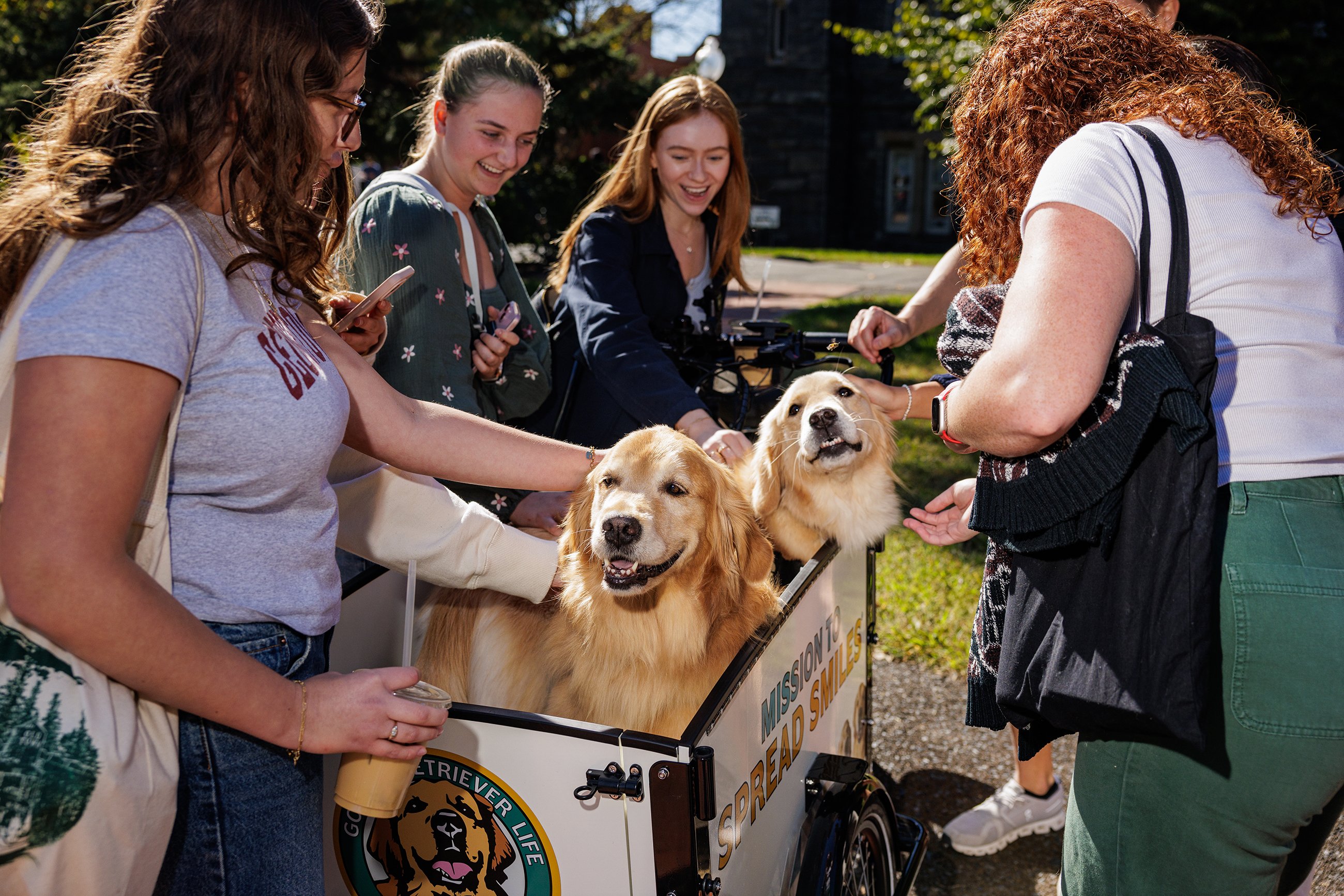
Inspired by his experience with a smile-spreading dog while deployed in Afghanistan, Kevin Bubolz got Ellie and decided to train her as a therapy dog, visiting hospitals and veterans. When the pandemic kept her out of those settings, Bubolz moved online, expanding Ellie’s paw print across the digital world. Emma joined the family two years later, following her older sister into a therapy and social-media career.
Today, the duo have 2.8 million followers on Instagram and 7.1 million on TikTok (@elliegoldenlife on both), where their extreme cuteness (donning bandannas! snuggling with sick children!) has earned them worldwide recognition. They’ve also scored paid brand deals with companies such as Target, Starbucks, and Yeti—though their real reward is fruit (Emma) or a good cut of meat (Ellie). “They know when we’re about to film—they just go nuts for it,” says Bubolz.
Ellie and Emma remain working therapy dogs, and once a week they have a day dedicated to philanthropy. The pair visit Children’s National every other week and have also stopped by the Pentagon and military bases across the world to snuggle servicemembers. Their signature move? When asked, “Could you hug your sister?” Emma will pop up and wrap her arms around Ellie with a grin. “A lot of people take photos, so it’s like, how can we add a little surprise?” Bubolz says. “You get this candid response from people. It’s really unique.”
Back to Top
The Service Dog

Norm
Labrador retriever, almost 5
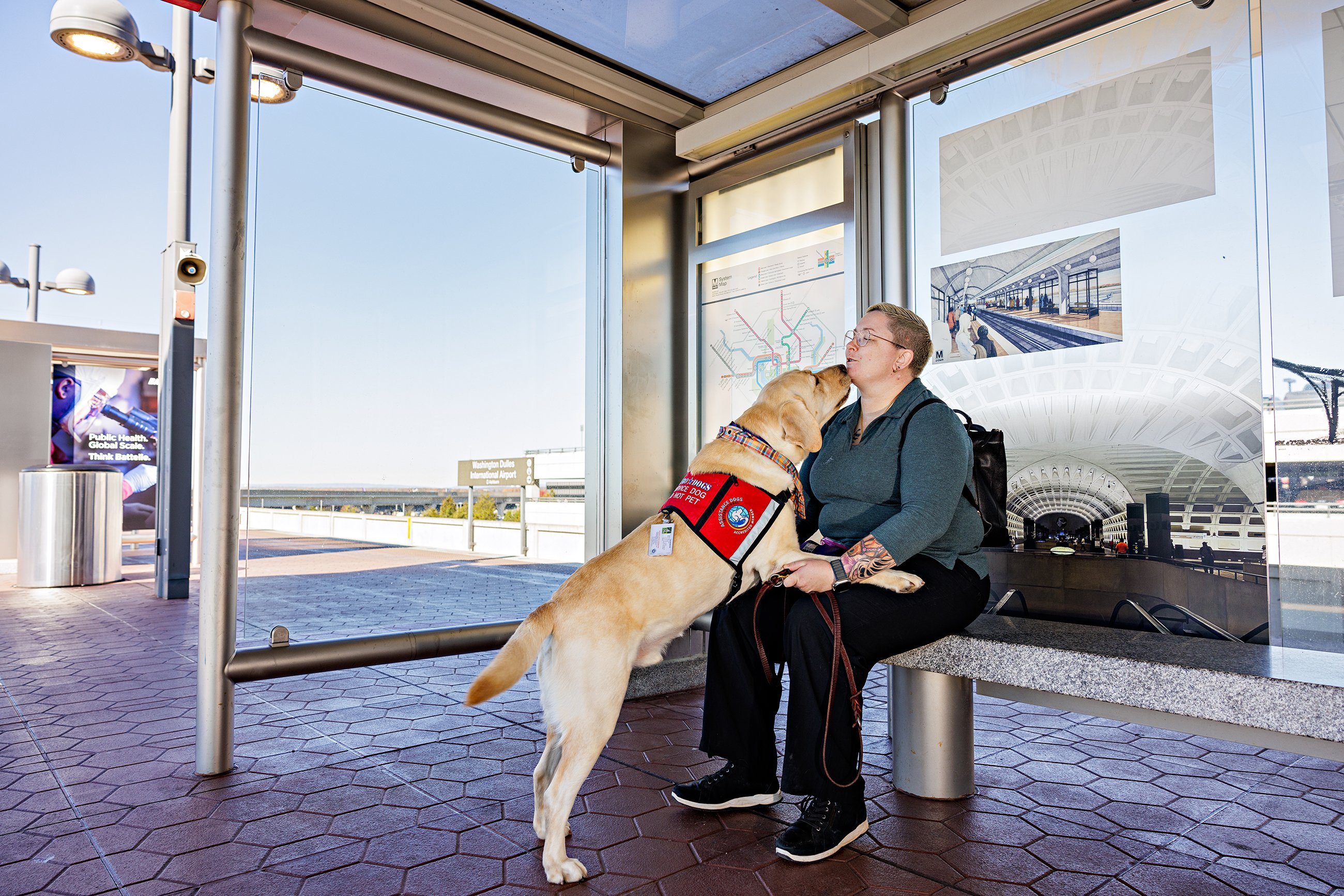
Years of responding to hurricanes, oil spills—including the Deepwater Horizon explosion—and other disasters as a Coast Guard member left Carole Baillie with an injured foot and posttraumatic stress disorder. She struggled with physical balance, depression, and anxiety that produced cold sweats.
Then Baillie connected with Hero Dogs, a Maryland nonprofit that places service dogs with veterans and disabled first responders. During her initial visit, Baillie met with staff to discuss her needs. “All I saw was giant paws,” she says. “That was Norm.”
The two are now inseparable. When Baillie is anxious, Norm will nudge his nose against her leg, place a paw over her foot, or lay his head on her chest to soothe her nerves and remind her to breathe deeply. If Baillie drops a debit card at the grocery store, he’ll pick it up. If Baillie’s drop foot causes her to fall, he’ll position himself as a support to help her get up.
Norm went to class with Baillie at George Washington University—and was by her side when she received her master’s in environmental-resource policy. He’s traveled to California, Illinois, Texas, and Hawaii, folding himself under Baillie’s legs during flights. He’s visited congressional offices as she’s advocated for veterans and is popular at the Environmental Protection Agency’s downtown headquarters, where Baillie works. “Norm has been life-changing,” she says. “He grounds me and keeps me sane. I appreciate things more, and I keep putting one foot in front of the other, all because of him.”
Back to Top
The Goose Chaser

Cowboy
Border collie, 10
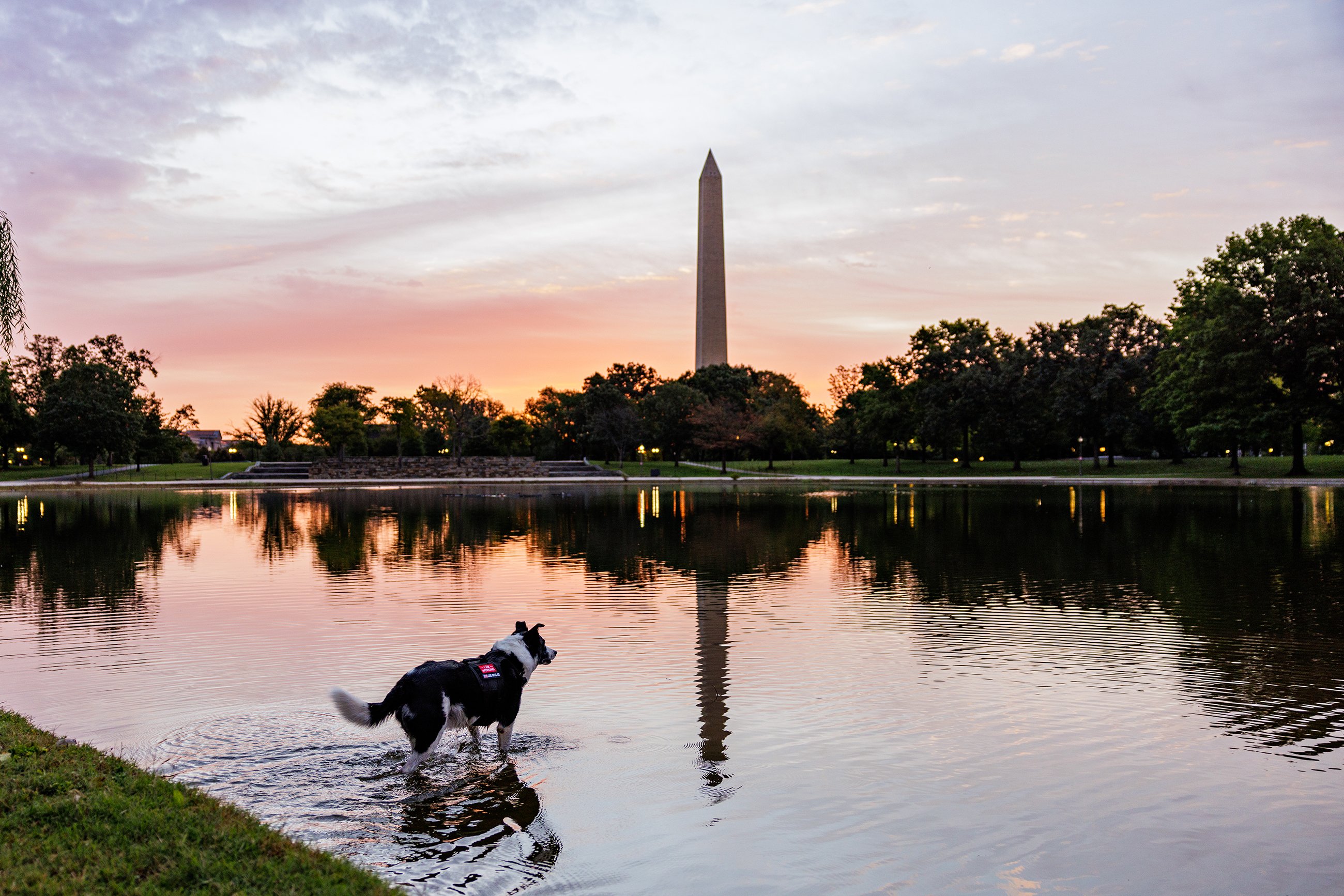
Ever notice a suspicious lack of geese near the Washington Monument? Thank Cowboy and his three collie colleagues at Capital Goose Control. Hired by the National Park Service to patrol the area between the monument and the Lincoln Memorial, each dog also visits about two dozen other sites a day, including parks and golf courses in DC and Virginia.
Athletic and highly intelligent, border col-lies thrive with jobs—prior to his goose-chasing career, Cowboy herded sheep, learning the basics of controlling and corralling other animals. His most important skill? “The eye,” which Capital Goose Control owner Doug Marcks says is the quintessential method for intimidating geese. Combining a hypnotic, wolf-like glare with low-to-the-ground stalking, Cowboy is able to make geese think they’re in danger, prompting them to leave an area without being touched—a removal technique approved as humane by the USDA Wildlife Services and People for the Ethical Treatment of Animals.
To succeed, goose dogs need the right temperament—if they’re quick to nip perceived prey, they could risk causing harm. Lucky for the birds, Marcks says, Cowboy is friendly, gentle, and on his best behavior at work—keeping the National Mall free of geese, as well as the smelly stuff they tend to leave behind.
The Truffle Sniffer
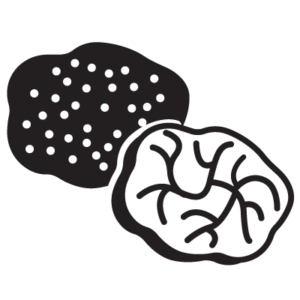
Nadine
Redbone coonhound, 13
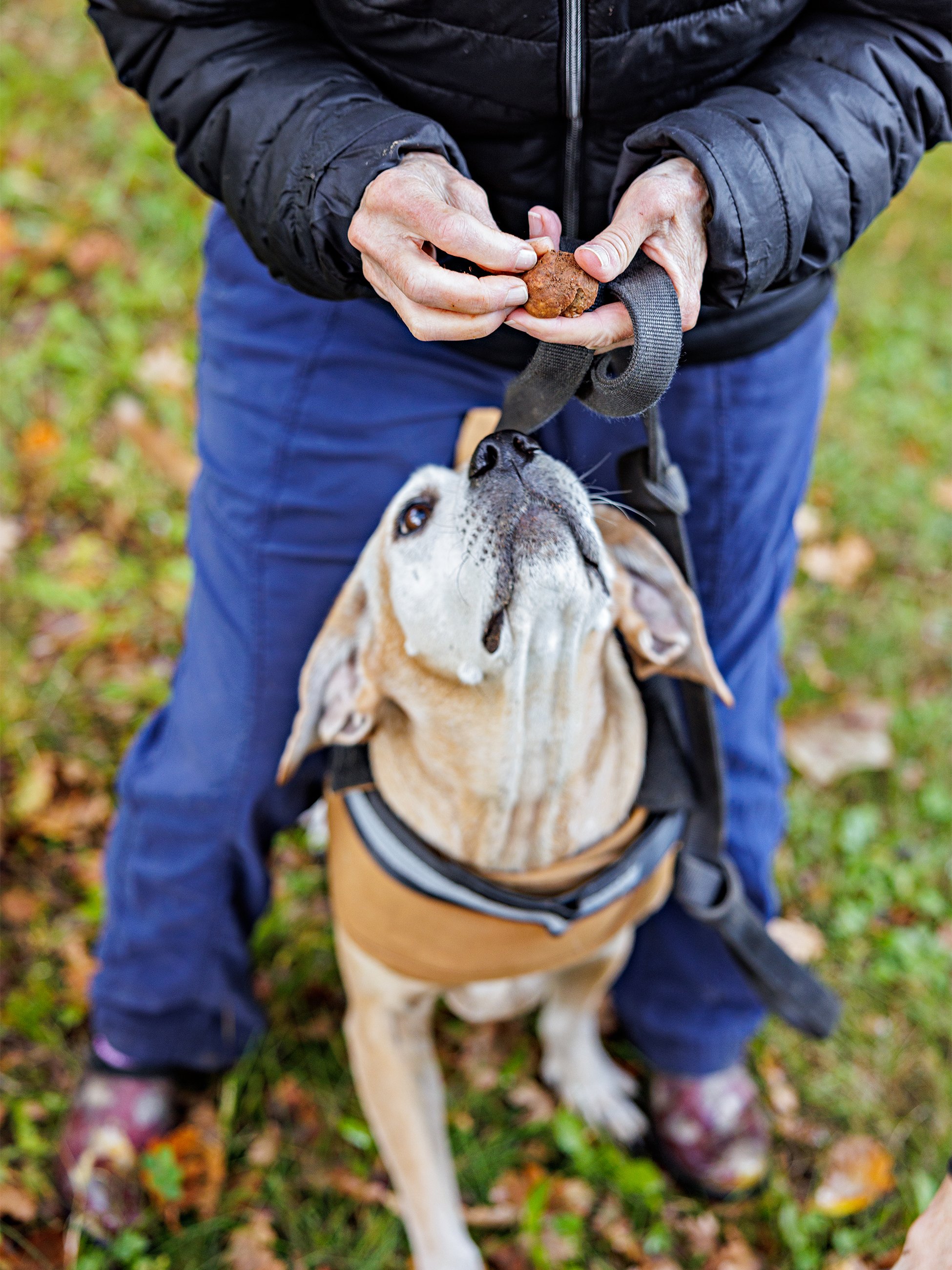
Straining at the leash attached to a harness embroidered with her name, Nadine beelines through the neat rows of English oak at a local orchard. She circles a tree, nose to the ground. Suddenly, she stops and begins pawing, throwing up dead leaves and clumps of moss.
Nadine’s handler eases her away, rewards her with a treat, and reaches into the hole, unearthing a bumpy, golf-ball-size sphere covered in dirt. It’s a Périgord black truffle, worth $800 to $1,200 a pound. For seven years, Nadine has been hunting these rare fungi at Virginia Truffles, a truffière (truffle farm) in Rixeyville, Virginia, seven miles north of Culpeper. Because truffles grow underground, Nadine’s keen sense of smell is required to determine where they’re growing and when they’re ripe enough to gather.
To train for her work, Nadine first spent a few days learning truffles’ scent. Next, she had to find hidden tea infusers containing truffles while ignoring empty ones. Finally, she had to ferret out truffles buried by her trainers—only then was she ready for live hunts like this one, which produces a few more Périgords and lasts just an hour or so. “You don’t want to overwork a truffle dog,” says Vanessa Shea, the truffière’s operations manager, “because they will either lose interest, get overly tired, or get cold. So after they harvest, you give them all the couch time, porch time, and nap time they want.”

long time ago, my family had a backyard pool. I would waddle toward the water, a curious and determined toddler, unaware that I didn’t know how to swim. Unfailingly, our dog—a high-strung collie/Australian shepherd named Sheila, a dead ringer for TV’s Lassie—would swoop in and knock me flat on my butt, averting potential disaster. Years later, when I was a teen, Sheila would still bark like the house was on fire every time I took a dip.
Looking back, I can’t blame her. She was only doing her job.
Humans and dogs have been laboring together for thousands of years, and scientists believe that many of the canine qualities we love are rooted in generations of purposeful breeding for particular tasks. Dogs have herded our livestock, guarded our property, hauled our sleds, helped us hunt. We’ve taken them to war (as far back as a battle in what is now Turkey, circa 600 BCE) and to outer space (a Russian dog, Laika, was the first animal to orbit the Earth).
Today, many dogs enjoy lives of domestic companionship: Belly rubs and playing fetch is their job. But others are still hard at work. Three years ago, the federal government employed about 5,600 dogs in roles ranging from detecting bioweapons and nuclear material to helping rangers traverse Denali National Park in winter. In Washington, working dogs are sniffing for bedbugs, helping wounded veterans live fuller lives, keeping the National Mall free of pesky geese, and otherwise getting the job done. Here are a few of their stories.
—Patrick Hruby
Back to Top
The Bedbug Sniffer

Ellie
German shepherd, almost 2

After about a year and a half of training, Ellie is at the beginning of her career. A few months back, she saw her first client, a woman in DC who was still getting bedbug bites, even after her apartment was chemically treated three times.
Bonita Parker, owner of Potomac Working Dogs, led Ellie around the apartment. She hit on the scent in a closet, pointing to several infested bags of clothes. Ellie also hit on a suitcase, and a light bulb went off for the client: This might be the source of the infestation, since she’d traveled with it right before the bites began.
Such is the advantage, Parker says, of hiring a dog like Ellie. Compared with a typical pest-control company, she can better help determine the scale and location of the problem, thereby allowing the subsequent treatment to be targeted. Parker and Ellie take this work very seriously; Ellie trained with a man who teaches military dogs to hunt for explosives. “He is very much about precision, because in explosive detection, there is really no room for error,” Parker says.
Still, Ellie remains a playful adolescent—during a Zoom call, Parker tried to coax her into her lap, then settled her dog on the floor with a treat. “She has a great on/off switch,” Parker says. “She’s like, ‘I’m in my play mode. I’m gonna do all the puppy things.’ And then it’s like, ‘Oh, I’m working.’ It’s a complete personality change.”
Back to Top
The Therapist

Captain Ellie Mae
Golden retriever, 6

Despite her badass camo vest, honorary Navy captain Ellie Mae hasn’t seen combat. As much as a dog can, though, she understands the toll of war on the human body and psyche. Specially bred and trained, she’s hypersensitive to the needs of veterans and injured servicemembers—a perfect fit for the therapy-dog program at Walter Reed National Military Medical Center, where she and seven other dogs roam the halls with a team of handlers.
While Ellie Mae can care for patients with mobility issues by opening doors and retrieving fallen objects from the floor, much of her work is emotional: Have you ever felt the rush of serotonin when a big, fluffy dog leans lovingly against your legs? “Her skill is love,” says Amy O’Connor, who heads the therapy-dog program. “That’s her superpower.”
Walter Reed isn’t just for Presidents and wounded warriors. Military family members are treated here, too. Ellie Mae spends a lot of time in the pediatric oncology ward, where the cartoons and patterns painted on the walls can lift spirits only so much. She’s often the dog of choice for kids going through chemo and other taxing treatments, because she pours on the affection, clambering into bed with them. In the hospital’s halls, passing families will often call to her by name. “They don’t know us half the time,” says Patty Barry, Ellie Mae’s dog mom and the program’s business manager. “But they certainly know her.”
Back to Top
The Rat Hunters


Choir Boy
Staghound, whippet, and pit-bull mix, 2
Mike
Smooth fox terrier, 4
Barto
Cairn terrier, 3
Pebbles
Patterdale and American pit-bull terrier mix, 2
Junior
Patterdale terrier, 11/2
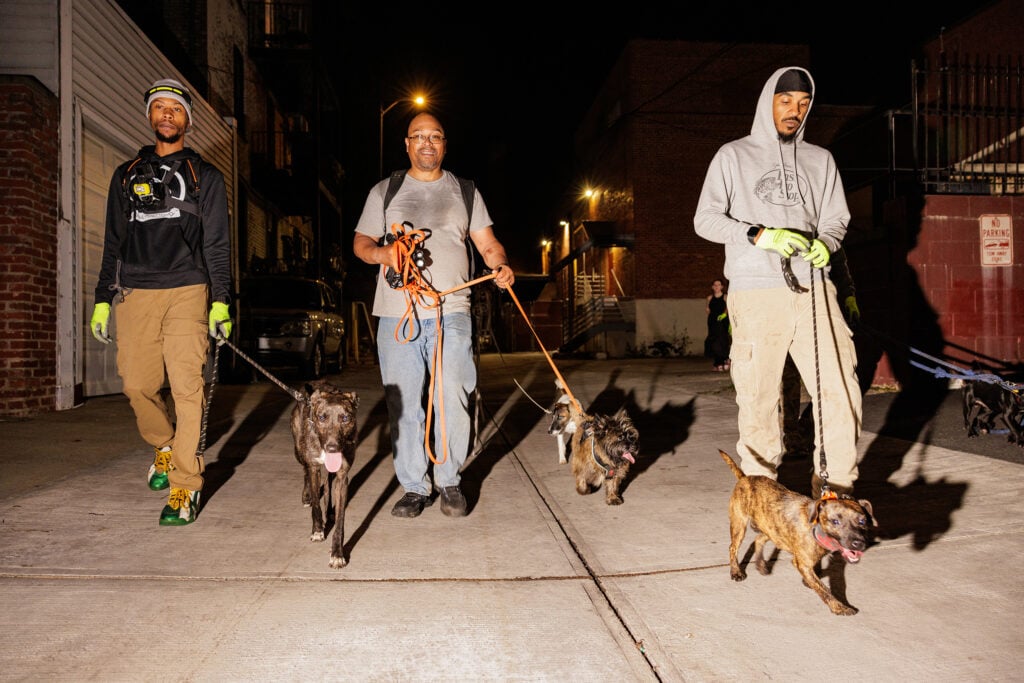
They call themselves the Renegade Rebel Ratters, and on a Saturday night in October, they gather in Adams Morgan to do what they do best: hunt rats. “The dogs like doing it, and we like doing it,” says group cofounder Bomani Mtume as his cairn terrier, Barto, readies himself for battle by looking, well, adorable. Mtume and Barto have hunted rats all over DC, but in the past year and a half, they’ve made this their favorite haunt after striking a deal with the local business district: free parking for a night of hunting.
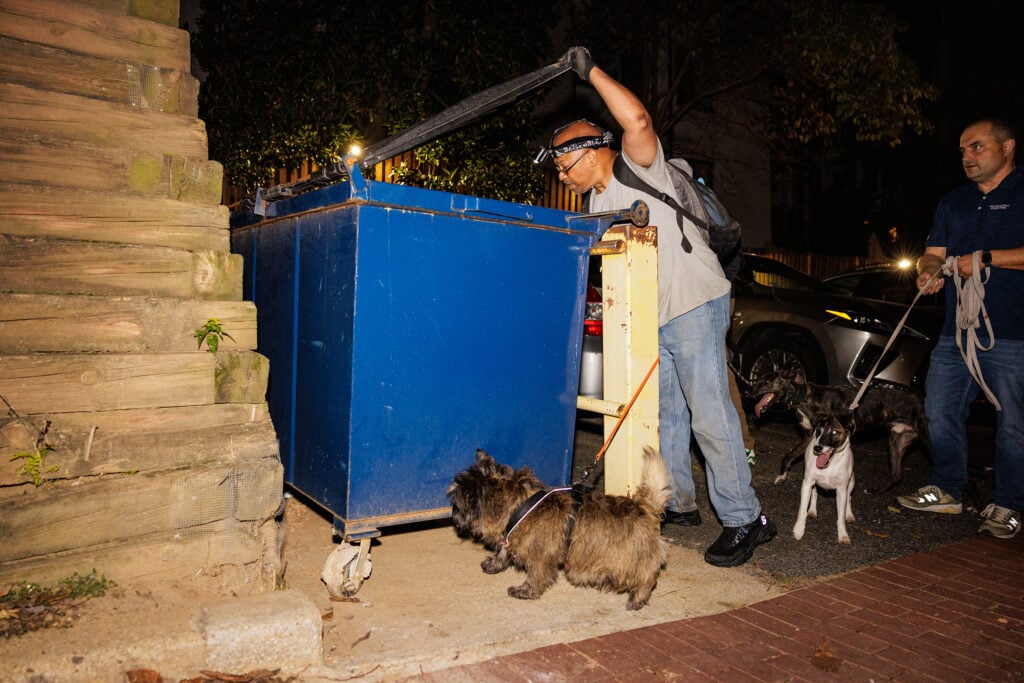
There’s a rich history of dogs hunting rats—a similar New York City group first formed in themid-1990s. But the need has never been greater in DC, recently named the nation’s “rattiest” city. Mtume helps organize hunts in which different dogs play different roles. “Push” dogs go into tight spaces, such as behind dumpsters, to flush rats out of hiding. “Catch” dogs, like Barto, are “genetically hardwired to hunt vermin,” Mtume says. “All they want to do is kill rats.” Then there are “lurchers”—bigger and faster dogs who mop up the rats that escape.
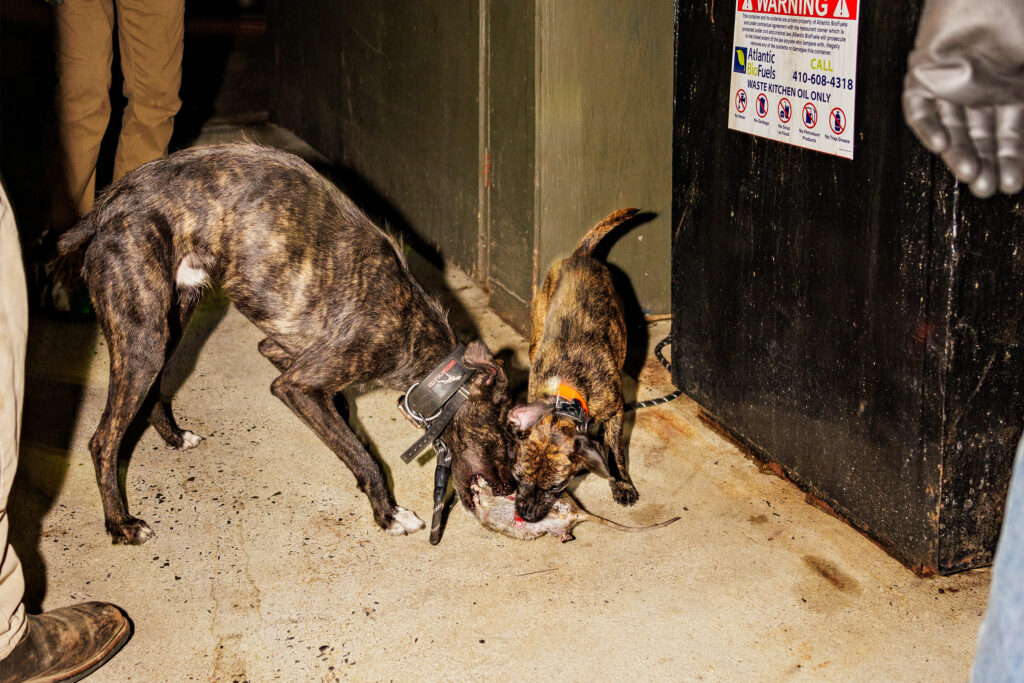
The dogs shake the rats violently by the neck. Groups such as People for the Ethical Treatment of Animals and DC’s Humane Rescue Alliance have criticized this practice. The dogs’ owners counter that death via canine happens within seconds, whereas rat poison used by exterminators causes internal bleeding and organ failure that can last as long as two weeks.
The dogs have never gotten sick, Mtume says, though they do suffer occasional bites. At 10 pm, the hunt be-gins behind a pair of green dumpsters and loops through the alleyways behind 18th Street. When it ends around midnight, the group has caught 29 rats, short of their record of 47. Along the way, a passing reveler voices his approval. “Thank you for your service,” he says. “Can I get a picture with the dogs?”
The Influencers

Ellie and Emma
Golden retrievers, 8 and 2

Inspired by his experience with a smile-spreading dog while deployed in Afghanistan, Kevin Bubolz got Ellie and decided to train her as a therapy dog, visiting hospitals and veterans. When the pandemic kept her out of those settings, Bubolz moved online, expanding Ellie’s paw print across the digital world. Emma joined the family two years later, following her older sister into a therapy and social-media career.
Today, the duo have 2.8 million followers on Instagram and 7.1 million on TikTok (@elliegoldenlife on both), where their extreme cuteness (donning bandannas! snuggling with sick children!) has earned them worldwide recognition. They’ve also scored paid brand deals with companies such as Target, Starbucks, and Yeti—though their real reward is fruit (Emma) or a good cut of meat (Ellie). “They know when we’re about to film—they just go nuts for it,” says Bubolz.
Ellie and Emma remain working therapy dogs, and once a week they have a day dedicated to philanthropy. The pair visit Children’s National every other week and have also stopped by the Pentagon and military bases across the world to snuggle servicemembers. Their signature move? When asked, “Could you hug your sister?” Emma will pop up and wrap her arms around Ellie with a grin. “A lot of people take photos, so it’s like, how can we add a little surprise?” Bubolz says. “You get this candid response from people. It’s really unique.”
Back to Top
The Service Dog

Norm
Labrador retriever, almost 5

Years of responding to hurricanes, oil spills—including the Deepwater Horizon explosion—and other disasters as a Coast Guard member left Carole Baillie with an injured foot and posttraumatic stress disorder. She struggled with physical balance, depression, and anxiety that produced cold sweats.
Then Baillie connected with Hero Dogs, a Maryland nonprofit that places service dogs with veterans and disabled first responders. During her initial visit, Baillie met with staff to discuss her needs. “All I saw was giant paws,” she says. “That was Norm.”
The two are now inseparable. When Baillie is anxious, Norm will nudge his nose against her leg, place a paw over her foot, or lay his head on her chest to soothe her nerves and remind her to breathe deeply. If Baillie drops a debit card at the grocery store, he’ll pick it up. If Baillie’s drop foot causes her to fall, he’ll position himself as a support to help her get up.
Norm went to class with Baillie at George Washington University—and was by her side when she received her master’s in environmental-resource policy. He’s traveled to California, Illinois, Texas, and Hawaii, folding himself under Baillie’s legs during flights. He’s visited congressional offices as she’s advocated for veterans and is popular at the Environmental Protection Agency’s downtown headquarters, where Baillie works. “Norm has been life-changing,” she says. “He grounds me and keeps me sane. I appreciate things more, and I keep putting one foot in front of the other, all because of him.”
Back to Top
The Goose Chaser

Cowboy
Border collie, 10

Ever notice a suspicious lack of geese near the Washington Monument? Thank Cowboy and his three collie colleagues at Capital Goose Control. Hired by the National Park Service to patrol the area between the monument and the Lincoln Memorial, each dog also visits about two dozen other sites a day, including parks and golf courses in DC and Virginia.
Athletic and highly intelligent, border col-lies thrive with jobs—prior to his goose-chasing career, Cowboy herded sheep, learning the basics of controlling and corralling other animals. His most important skill? “The eye,” which Capital Goose Control owner Doug Marcks says is the quintessential method for intimidating geese. Combining a hypnotic, wolf-like glare with low-to-the-ground stalking, Cowboy is able to make geese think they’re in danger, prompting them to leave an area without being touched—a removal technique approved as humane by the USDA Wildlife Services and People for the Ethical Treatment of Animals.
To succeed, goose dogs need the right temperament—if they’re quick to nip perceived prey, they could risk causing harm. Lucky for the birds, Marcks says, Cowboy is friendly, gentle, and on his best behavior at work—keeping the National Mall free of geese, as well as the smelly stuff they tend to leave behind.
The Truffle Sniffer

Nadine
Redbone coonhound, 13

Straining at the leash attached to a harness embroidered with her name, Nadine beelines through the neat rows of English oak at a local orchard. She circles a tree, nose to the ground. Suddenly, she stops and begins pawing, throwing up dead leaves and clumps of moss.
Nadine’s handler eases her away, rewards her with a treat, and reaches into the hole, unearthing a bumpy, golf-ball-size sphere covered in dirt. It’s a Périgord black truffle, worth $800 to $1,200 a pound. For seven years, Nadine has been hunting these rare fungi at Virginia Truffles, a truffière (truffle farm) in Rixeyville, Virginia, seven miles north of Culpeper. Because truffles grow underground, Nadine’s keen sense of smell is required to determine where they’re growing and when they’re ripe enough to gather.
To train for her work, Nadine first spent a few days learning truffles’ scent. Next, she had to find hidden tea infusers containing truffles while ignoring empty ones. Finally, she had to ferret out truffles buried by her trainers—only then was she ready for live hunts like this one, which produces a few more Périgords and lasts just an hour or so. “You don’t want to overwork a truffle dog,” says Vanessa Shea, the truffière’s operations manager, “because they will either lose interest, get overly tired, or get cold. So after they harvest, you give them all the couch time, porch time, and nap time they want.”
This article appears in the December 2024 issue of Washingtonian.
